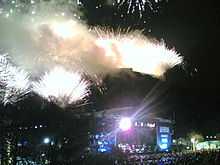Fireworks




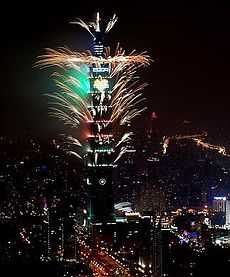

Fireworks are a class of explosive pyrotechnic devices used for aesthetic, cultural, and religious purposes. A fireworks event (also called a fireworks show or pyrotechnics) is a display of the effects produced by firework devices. Fireworks competitions are also regularly held at a number of places. Fireworks take many forms to produce the four primary effects: noise, light, smoke and floating materials (confetti for example.) They may be designed to burn with flames and sparks of many colors, typically red, orange, yellow, green, blue, purple, , silver and gold. Displays are common throughout the world and are the focal point of many cultural and religious[2] celebrations.
The earliest documentation of fireworks dates back to 7th century China, where they were invented. The fireworks were used to accompany many festivities. It is a part of the culture of China and had its origin there; eventually it spread to other cultures and societies.[3] Important events and festivities such as the Spring Festival (Chinese New Year) and the Mid-Autumn Festival were and still are times when fireworks are guaranteed sights. China is the largest manufacturer and exporter of fireworks in the world.[4]
Fireworks are generally classified as to where they perform, either as a ground or aerial firework. In the latter case they may provide their own propulsion (skyrocket) or be shot into the air by a mortar (aerial shell). The most common feature of fireworks is a paper or pasteboard tube or casing filled with the combustible material, often pyrotechnic stars. A number of these tubes or cases are often combined so as to make, when kindled, a great variety of sparkling shapes, often variously colored. The skyrocket is a common form of firework, although the first skyrockets were used in war. Such rocket technology has also been used for the delivery of mail by rocket and is used as propulsion for most model rockets. The aerial shell is the backbone of today's commercial aerial display. A smaller version for consumer use is known as the festival ball in the United States. There are also ground fireworks which, while less popular than aerial fireworks, can produce various shapes, like rotating circles, stars and 3D globes.[5]
History

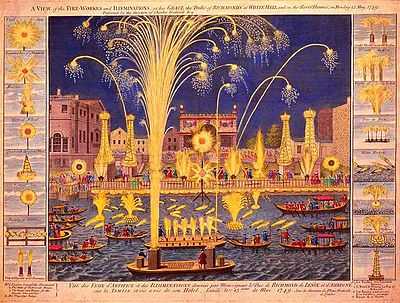



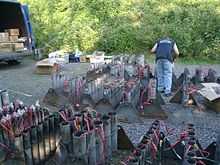
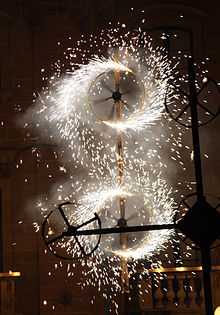

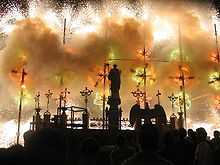
The earliest documentation of fireworks dates back to 7th century China, where they were invented. The fireworks were used to accompany many festivities. It is a part of the culture of China and had its origin there; eventually it spread to other cultures and societies.[3] The art and science of firework making has developed into an independent profession. In China, pyrotechnicians were respected for their knowledge of complex techniques in mounting firework displays.[6]
During the Song Dynasty (960–1279), many of the common people could purchase various kinds of fireworks from market vendors,[7] and grand displays of fireworks were also known to be held. In 1110, a large fireworks display in a martial demonstration was held to entertain Emperor Huizong of Song (r. 1100–1125) and his court.[8] A record from 1264 states that a rocket-propelled firework went off near the Empress Dowager Gong Sheng and startled her during a feast held in her honor by her son Emperor Lizong of Song (r. 1224–1264).[9] Rocket propulsion was common in warfare, as evidenced by the Huolongjing compiled by Liu Ji (1311–1375) and Jiao Yu (fl. c. 1350–1412).[10] In 1240 the Arabs acquired knowledge of gunpowder and its uses from China. A Syrian named Hasan al-Rammah wrote of rockets, fireworks, and other incendiaries, using terms that suggested he derived his knowledge from Chinese sources, such as his references to fireworks as "Chinese flowers".[3][11]
With the development of chinoiserie in Europe, Chinese fireworks began to gain popularity around the mid-17th century.[12] Lev Izmailov, ambassador of Peter the Great, once reported from China: "They make such fireworks that no one in Europe has ever seen."[12] In 1758, the Jesuit missionary Pierre Nicolas le Chéron d'Incarville, living in Beijing, wrote about the methods and composition on how to make many types of Chinese fireworks to the Paris Academy of Sciences, which revealed and published the account five years later.[13] His writings would be translated in 1765, resulting in the popularization of fireworks and further attempts to uncover the secrets of Chinese fireworks.[13]
Amédée-François Frézier published his revised work Traité des feux d'artice pour le spectacle (Treatise on Fireworks) in 1747 (originally 1706),[14] covering the recreational and ceremonial uses of fireworks, rather than their military uses.
Music for the Royal Fireworks was composed by George Frideric Handel in 1749 to celebrate the peace Treaty of Aix-la-Chapelle, which had been declared the previous year.
Safety
Improper use of fireworks may be unsafe, both to the person operating them (risks of burns and wounds) and to bystanders; in addition, they may start fires after landing on flammable material. For this reason, the use of fireworks is generally legally restricted. Display fireworks are restricted by law for use by professionals; consumer items, available to the public, are smaller versions containing limited amounts of explosive material to reduce potential danger. Fireworks may pose a problem for animals, both domestic and wild, who can be terrified by the noise, leading to them running away or hurting themselves on fences or in other ways in an attempt to escape. With proper desensitization training the number of pets going missing due to fireworks can be reduced.[15][16][17][18]
Competitions
Pyrotechnical competitions involving fireworks are held in many countries. One of the most prestigious fireworks competitions is the Montreal Fireworks Festival, an annual competition held in Montreal, Quebec, Canada. Another magnificent competition is Le Festival d’Art Pyrotechnique held in the summer annually at the Bay of Cannes in Côte d'Azur, France. The World Pyro Olympics is an annual competition among the top fireworks companies in the world. It is held in Manila, Philippines. The event is one of the largest and most intense international fireworks competitions. DIFC DaNang International Fireworks Competition is held yearly in DaNang, Vietnam. Liuyang International Fireworks Competition held in Liuyang City, Hunan Province, China.
Fireworks world records
The current Guinness World Records as of Jan,1 2014 are:
Largest firework display of all time
Dubai during the 2014 New Years celebrations broke the record for the most fireworks ignited during a single coordinated display. According to Guiness World Records: "Covering a distance of over 94km (61.6 miles) of the city’s seafront, the display incorporated some of Dubai’s top landmarks, including Palm Jumeirah, World Islands, the Burj Khalifa and Burj Al Arab. Ten months in planning, over 500,000 fireworks were used during the display which lasted around six minutes, with Guinness World Records adjudicators on hand to confirm that a new record had been set."[19]
Largest Catherine wheel
A self-propelled vertical firework wheel was designed by The Lily Fireworks Factory and fired for at least one revolution on the eve of the annual festival of Our Lady Of The Lilies.[20] The Lily Fireworks Factory, Mqabba, Malta currently possesses this record, burning a Catherine Wheel with a diameter of 32.044 m (105 ft 1.56 in), on June 18, 2011.[21]
Longest firework waterfall
The world's longest firework waterfall was the 'Niagara Falls', which measured 3,517.23 m (11,539 ft 5 in) when ignited on August 23, 2008 at the Ariake Seas Fireworks Festival, Fukuoka, Japan.[22]
Most firework rockets launched in 30 seconds
The most firework rockets launched in 30 seconds is 125,801, organized by Pyroworks International Inc. (Philippines), in Cebu, Philippines, on May 8, 2010.[23]
Largest firework rocket
The largest firework rocket is 13.40 kg (29.53 lb) and was produced and launched by Associação Nacional de Empresas de Produtos Explosivos (Portugal) at the 12th International Symposium on Fireworks in Oporto and Vila Nova de Gaia, Portugal, on October 13, 2010.[24]
Clubs
Enthusiasts in the United States have formed clubs which unite hobbyists and professionals. The groups provide safety instruction and organize meetings and private “shoots” at remote premises where members shoot commercial fireworks as well as fire pieces of their own manufacture. Clubs secure permission to fire items otherwise banned by state or local ordinances. Competitions are held among members and between clubs, demonstrating everything from single shells to elaborate displays choreographed to music. One of the oldest clubs is CrackerJacks, Inc.,[25] organized in 1976 in the Eastern Seaboard region of the U.S.
Pyrotechnics Guild International
The Pyrotechnics Guild International, Inc. or PGI,[26] founded in 1969, is an independent worldwide nonprofit organization of amateur and professional fireworks enthusiasts. It is notable for its large number of members, around 3,500 in total. The PGI exists solely to further the safe usage and enjoyment of both professional grade and consumer grade fireworks while both advancing the art and craft of pyrotechnics and preserving its historical aspects. Each August the PGI conducts its annual week-long convention, where some the world's biggest and best fireworks displays occur. Vendors, competitors, and club members come from around the USA and from various parts of the globe to enjoy the show and to help out at this all-volunteer event. Aside from the nightly firework shows, the competition is a highlight of the convention. This is a completely unique event where individual classes of hand-built fireworks are competitively judged, ranging from simple fireworks rockets to extremely large and complex aerial shells. Some of the biggest, best, most intricate fireworks displays in the United States take place during the convention week.
Amateur and professional members can come to the convention to purchase fireworks, paper goods, novelty items, non-explosive chemical components and much more at the PGI trade show. Before the nightly fireworks displays and competitions, club members have a chance to enjoy open shooting of any and all legal consumer or professional grade fireworks, as well as testing and display of hand-built fireworks. The week ends with the Grand Public Display on Friday night, which gives the chosen display company a chance to strut their stuff in front of some of the world's biggest fireworks aficionados. The stakes are high and much planning is put into the show. In 1994 a shell of 36 inches (910 mm) in diameter was fired during the convention, more than twice as large as the largest shell usually seen in the USA, and shells as large as 24 inches (610 mm) are frequently fired.
Western Pyrotechnic Association
Because of enthusiasm for display fireworks west of the Rocky Mountains, The WPA[27] was formed in 1989 in part because of the travel distances required to attend PGI events in the U.S. Mid-West. The organization sponsors two major firework events per year, almost always at Lake Havasu, Arizona. Activities are similar (except sometimes in scale) to those at PGI conventions. Most members of the WPA are firework professionals, who claim it's essential to have a few opportunities per year to perform shows strictly for fun, as well as for other pros. Many of these men and women like to teach workshops (including manufacturing workshops) during these events as well.
Halloween
In Ireland (both the Republic of Ireland and Northern Ireland), during the Halloween season, there are many fireworks displays. The largest are in the cities of Belfast, Derry and Dublin. In 2010, the Halloween fireworks display in Derry captivated an audience of over 20,000 people.[28] The sale of fireworks is strongly restricted in the Republic of Ireland, though many illegal fireworks are sold throughout October or smuggled over the Northern Ireland border (where there is a large black market for fireworks). In the Republic, the punishment for possessing fireworks without a license is a €10,000 fine for possessing them, and/or a five-year prison sentence. The punishment for having or lighting fireworks in a public place is the same.
Both fireworks and firecrackers are a popular tradition during Halloween in Nova Scotia and Vancouver, although apparently this is not the custom elsewhere in Canada. The two known firework displays used during All Hallows' Eve in the United States are the annual "Happy Hallowishes" show at Walt Disney World's Magic Kingdom "Mickey's Not-So-Scary Halloween Party" event, which began in 2005, and the "Halloween Screams" at Disneyland Park, which began on September 25, 2009.
Olympics
Fireworks play a major role during the ceremonies for the Summer and Winter Olympic Games. In the opening ceremonies, the fireworks will go off all across the stadium when a person declares the competition open. This also occurs when the cauldron is officially lit by an athlete at the end of the ceremony with the Olympic Torch. In the closing ceremonies, the fireworks appear once again at the end when the flame is extinguished.
Fireworks celebrations throughout the world
Japanese fireworks festivals
During the summer in Japan, fireworks festivals (花火大会 hanabi taikai) are held nearly every day someplace in the country, in total numbering more than 200 during August. The festivals consist of large fireworks shows, the largest of which use between 100,000 and 120,000 rounds (PL Art of Fireworks), and can attract more than 800,000 spectators. Street vendors set up stalls to sell various drinks and staple Japanese food (such as Yakisoba, Okonomiyaki, Takoyaki, kakigori (shaved ice), and traditionally held festival games, such as Kingyo-sukui, or Goldfish scooping.
Even today, men and women attend these events wearing the traditional Yukata, summer Kimono, or Jinbei (men only), collecting in large social circles of family or friends to sit picnic-like, eating and drinking, while watching the show.
The first fireworks festival in Japan was held in 1733.[29]

Indian fireworks celebrations
Indians throughout the world celebrate with fireworks as part of their popular "festival of lights" (Diwali) on new - moon day (Amavasya) of Aswayuja month which generally falls in Oct–Nov every year. Quieter varieties of fireworks are more popular for this festival as its a festival of light celebrated on the new moon night. It is the festival of Hindu religion.
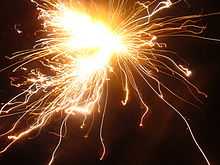
Philippines fireworks celebrations
The World Pyro Olympics is an annual fireworks competition held in the Philippines which runs for five days. Every day, there would be two competitors from around the world who battle to set up the grandest possible fireworks display. The host of the event does not participate in the competition but performs a fireworks display on the last night. Awards, such as the People’s Choice, are given out after the exhibition. The crowning of the World Pyro Olympics Champion ends the event.
Singapore fireworks celebrations

The Singapore Fireworks Celebrations (previously the Singapore Fireworks Festival) is an annual event held in Singapore as part of its National Day celebrations. The festival features local and foreign teams which launch displays on different nights. While currently non-competitive in nature, the organizer has plans to introduce a competitive element in the future.
The annual festival has grown in magnitude, from 4,000 rounds used in 2004, 6,000 in 2005, to over 9,100 in 2006.
United Kingdom fireworks festivals
One of the biggest occasions for fireworks in Great Britain is Guy Fawkes Night held each year on November 5, while the biggest in Northern Ireland takes place at Halloween. Guy Fawkes Night is a celebration of the foiling of the Gunpowder Plot on November 5, 1605, an attempt to kill King James I.
There are many firework societies in the counties of East Sussex and West Sussex which were at one time a single county. The societies predate the county boundary changes and are still known collectively as Sussex Bonfire Societies.
United States fireworks celebrations

America's earliest settlers brought their enthusiasm for fireworks to the United States. Fireworks and black ash were used to celebrate important events long before the American Revolutionary War. The very first celebration of Independence Day was in 1777, six years before Americans knew whether the new nation would survive the war; fireworks were a part of all festivities. In 1789, George Washington's inauguration was also accompanied by a fireworks display. This early fascination with their noise and color continues today. On New Year's Eve, there are special fireworks shows to signal the arrival of the New Year at the stroke of midnight like the famous ball drop in New York City's Times Square.
In 1976, Macy's sponsored the annual fireworks show from New York City and is televised live on NBC since its debut. Over three million people came to see the show in person, while the telecast on NBC attracted millions of viewers. The show takes place in the East River and the Hudson River.
In 1999, Walt Disney World in Lake Buena Vista, Florida, pioneered the commercial use of aerial fireworks launched with compressed air rather than gunpowder for the Epcot night time spectacular, IllumiNations: Reflections of Earth. The display shell explodes in the air using an electronic timer. The advantages of compressed air launch are a reduction in fumes, and much greater accuracy in height and timing.[30]
The Walt Disney Company is the largest consumer of fireworks in the United States.
Currently, the largest annual pyrotechnic display in North America is Thunder Over Louisville which kicks off the Kentucky Derby Festival.
The second largest fireworks display in North America is Cincinnati Bell/WEBN Riverfest fireworks display. This incredible pyrotechnic display takes place over the Ohio river between the border of Ohio (Cincinnati) and Kentucky (Covington). It attracts over 500,000 people each year and over 2,500 viewers by boat. It is televised on WLWT and broadcast over the internet for millions of viewers. This annual event has taken place Labor Day weekend since 1977.
Every year, on the 4th of July, Pyrotechnic Innovations has a live webcam that shows a crew setting up a professional fireworks display. It gives a behind the scenes look at what goes into a large display.
One of the world's largest fireworks companies, Zambelli Fireworks, is based in New Castle, Pennsylvania.[31] Subsequently, due to Zambelli's influence in the fireworks industry, New Castle is known as the "Fireworks Capital of America," a name the city government trademarked in 2006.[32]
In the United states, fireworks displays are a popular patriotic tradition on the Fourth of July, but almost all of the fireworks exploded in the US are hand-made made in China.[33] An American's invention to automate the process, patented in both the U.S. and China, has generated similar devices but no sales in China.[34]
Seoul International Firework Festival
Seoul International Firework Festival[35] has been held since last 2000. It was held at the Han River in 2000.10.07 with 4 major country's participating for the first time. South Korea, United States, Japan, and China took part in this festival hoping to successfully hold the upcoming 2002 South Korea&Japan Worldcup[36] and for the harmony of Korean people.
From 2000, the festival has been held in the same area, and not only the citizens of seoul but includes other provinces. people from abroad also enjoy one of the most beautiful fireworks festival in the world.
North Korea Firework Festival
Fireworks have been used in Kaesong on Buddha's Birthday (April 8).
Uses other than public displays
Consumer fireworks are fireworks the general public can buy. They typically have less explosive power than professional fireworks, but can still produce an acceptable show. Some examples of consumer fireworks are firecrackers, rockets, cakes (multishot aerial fireworks) and smoke balls.
Fireworks can also be used in an agricultural capacity as bird scarers.
Fireworks classifications

North America
The Canadian, Mexican, and United States governments classify fireworks and similar devices according to their potential hazards using the United Nations explosives shipping classification system. This system is based on hazard in shipping only, vs. the old USA system of both shipping and use hazards.
The UN classification system consists of five parts: the Primary class, the Secondary class indicating the hazard potential, the Compatibility Group, the UN Number an international code assigned to a specific dangerous good, and the Shipping Name describing the type of dangerous good in clear language.
Here are some common fireworks classes:
- Class 1.1G (Mass Explosion Possible:Pyrotechnics) e.g.: UN0094 Flashpowder
- Class 1.1G (Mass Explosion Possible:Pyrotechnics) e.g.: UN0333 Fireworks (Salutes in bulk or in manufacture)
- Class 1.2G (Projection but not mass explosion:Pyrotechnics) e.g.: UN0334 Fireworks (Rarely used)
- Class 1.3G (Fire, Minor Blast:Pyrotechnics) e.g.: UN0335 Fireworks (Most Display Fireworks)
- Current US law states that without appropriate ATF license/permit, the possession or sale of any display/professional fireworks is a felony punishable by up to 5 years in prison.
- Any ground salute device with over 50 milligrams (0.0018 oz) of explosive composition
- Torpedoes (except for railroad signaling use)
- Multi-tube devices containing over 500 grams (17.6 oz) of pyrotechnic composition and without 1/2" space between each tube
- Any multiple tube fountains with over 500 grams (17.6 oz) of pyrotechnic composition and without 1/2" space between each tube
- Any reloadable aerial shells over 1.75" diameter
- Display shells
- Any single-shot or reloadable aerial shell/mine/comet/tube with over 60 grams (2.1 oz) of pyrotechnic composition
- Any Roman candle or rocket with over 20 grams (0.7 oz) of pyrotechnic composition
- Any aerial salute with over 130 milligrams (0.0046 oz) of explosive composition
- Class 1.4G (Minor Explosion Hazard Confined To Package:Pyrotechnics) e.g.: UN0336 Fireworks (Consumer or Common Fireworks)
- Most popular consumer fireworks sold in the US, including:
- Reloadable aerial shells 1.75" or less sold in a box with not more than 12 shells and one launching tube
- Single-shot aerial tubes
- Bottle rockets
- Skyrockets and missiles
- Ground spinners, pinwheels and helicopters
- Flares & fountains
- Roman candles
- Smoke and novelty items
- Multi-shot aerial devices, or "cakes"
- Firecracker packs (see this link for various brand/label images). Although some firecracker items may be called "M-80's", "M-1000's", "Cherry bombs" or "Silver Salutes" by the manufacturer, they must contain less than 50 milligrams (0.0018 oz) of flash or other explosive powder in order to be legally sold to consumers in the United States.
- Sparklers
- Catherine wheel
- Black snakes and strobes
- Mines
- Class 1.4S (Minor Explosion Hazard Confined To Package: Packed As To Not Hinder Nearby Firefighters) e.g.:UN0336 Fireworks (Consumer or Common Fireworks)
- Class 1.4G (Minor Explosion Hazard Confined To Package:Pyrotechnics) e.g.: UN0431 ARTICLES, PYROTECHNIC for technical purposes (Proximate Pyrotechnics)
- Class 1.4S (Minor Explosion Hazard Confined To Package: Packed As To Not Hinder Nearby Firefighters) e.g.: UN0432 ARTICLES, PYROTECHNIC for technical purposes (Proximate Pyrotechnics)
Previous US Department of Transportation explosives classifications
Explosives, including fireworks, were previously divided into three classifications for transportation purposes by the DOT.
- Class A explosives included high explosives such as dynamite, TNT, blasting caps, packages of flash powder, bulk packages of black powder and blasting agents such as ANFO and other slurry types of explosives.
- Class B explosives included low explosives such as "display fireworks" which were the larger and more powerful fireworks used at most public displays.
- Class C explosives included other low explosives such as igniters, fuses and "common fireworks", which were the smaller and less powerful fireworks available for sale to and use by the general public.
At the time, the purchase and use of all of these explosives (with specific exceptions for high explosives purchased and used in state, black powder used for sporting purposes and common fireworks) required either a Bureau of Alcohol, Tobacco and Firearms (ATF) license or permit to purchase and use, and/or a state or local license or permit to purchase and use. The BATF and most states performed a direct substitution of Shipping Class 1.3 for Class B, and Shipping Class 1.4 for Class C. This allows some hazardous items that would have previously been classified as Class B and regulated to be classified as Shipping Class 1.4 due to a packaging method that confines any explosion to the package. Being Shipping Class 1.4, they can now be sold to the general public and are unregulated by the BATF.
British fireworks classification
Britain has its own system of classifying fireworks.
- Category 1 – indoor fireworks, for use in small areas.
- Category 2 – garden fireworks; must be safely viewable from 5 m (16 ft) and must not scatter debris beyond 3 m (9.8 ft).
- Category 3 – display fireworks; must be safely viewable from 5 m (16 ft) and must not scatter debris beyond 50 m (160 ft).
- Category 4 – professional fireworks; a person must have adequate insurance and storage to purchase and use these fireworks. Insurance can only be obtained once they have acknowledged the safe use and storage of Category 4 fireworks. There is no such thing as a "license" to buy or use Category 4 fireworks.
Pyrotechnic compounds


Colors in fireworks are usually generated by pyrotechnic stars—usually just called stars—which produce intense light when ignited. Stars contain five basic types of ingredients.
- A fuel which allows the star to burn
- An oxidizer— a compound which chemically oxidizes the fuel, necessary for combustion
- Color-producing chemicals
- A binder which holds the compound together.
- A chlorine donor which provides chlorine to strengthen the color of the flame. Sometimes the oxidizer can serve this purpose.
Some of the more common color-producing compounds are tabulated here. The color of a compound in a firework will be the same as its color in a flame test (shown at right). Not all compounds that produce a colored flame are appropriate for coloring fireworks, however. Ideal colorants will produce a pure, intense color when present in moderate concentration.
| Color | Metal |
|---|---|
| Red | Strontium (intense red)
Lithium (medium red) |
| Orange | Calcium |
| Yellow | Sodium |
| Apple Green | Barium |
| Blue | Copper |
| Azure | Cesium |
| Violet | Potassium (light pinkish violet)
Rubidium (violet-red) |
| Gold | Charcoal, iron, or lampblack |
| White | Titanium, aluminum, beryllium, or magnesium powders |
The brightest stars, often called Mag Stars, are fueled by aluminum. Magnesium is rarely used in the fireworks industry due to its lack of ability to form a protective oxide layer. Often an alloy of both metals called magnalium is used.
Many of the chemicals used in the manufacture of fireworks are non-toxic, while many more have some degree of toxicity, can cause skin sensitivity, or exist in dust form and are thereby inhalation hazards. Others, such as barium chloride are poisons if directly ingested or inhaled.
Abstract reference of chemicals used in fireworks industry
The following table is an educational guideline for the chemistry of fireworks.
| Symbol | Name | Fireworks Usage | Color |
|---|---|---|---|
| |
Aluminum | Aluminum is used to produce silver and white flames and sparks. It is a common component of sparklers. | silver, white |
| |
Barium | Barium is used to create greenish colors in fireworks. | apple green |
| Carbon | Carbon is one of the main components of black powder, which is used as a propellant in fireworks. Carbon provides the fuel for a firework. Common forms include carbon black, sugar, or starch. | ||
| Calcium | Calcium is used to deepen firework colors. Calcium salts produce orange fireworks. | orange | |
| Chlorine | Chlorine is an important component of many oxidizers in fireworks. Several of the metal salts that produce colors contain chlorine. | ||
| Cesium | Cesium compounds help to oxidize firework mixtures. Cesium compounds produce an azure (sky-blue) color in fireworks. | light blue | |
| Copper | Copper produces blue-green colors in fireworks and halides of copper are used to make shades of blue. | blue-green, blue | |
| Iron | Iron is used to produce sparks. The heat of the metal determines the color of the sparks. (Think of "red hot.") Current technology does not allow the generation of sufficient heat to make the iron glow blue (as in a "blue giant" star). | yellow through red | |
| Potassium | Potassium compounds help to oxidize firework mixtures. Potassium nitrate, potassium chlorate, and potassium perchlorate are all important oxidizers. The potassium content can impart a violet-pink color to the sparks. | violet-pink | |
| Lithium | Lithium is a metal that is used to impart a red color to fireworks. Lithium carbonate, in particular, is a common colorant. | red | |
| Magnesium | Magnesium burns an extremely brilliantindeed, almost blindingly sowhite, so it is used to add white sparks or improve the overall brilliance of a firework. | dazzling white | |
| Sodium | Sodium imparts a yellow color to fireworks, however, the color is often so bright that it frequently masks less intense colors. | yellow | |
| Oxygen | Fireworks include oxidizers, which are substances that produce oxygen in order for burning to occur. The oxidizers are usually nitrates, chlorates, or perchlorates. Sometimes the same substance is used to provide oxygen and color. | ||
| Phosphorus | Phosphorus burns spontaneously in air and is also responsible for some glow in the dark effects. It may be a component of a firework's fuel. | ||
| Rubidium | Rubidium compounds help to oxidize firework mixtures. Rubidium compounds produce a violet-red color in fireworks. | violet-red | |
| Sulfur | Sulfur is a component of black powder, and as such, it is found in a firework's propellant/fuel. | ||
| Antimony | Antimony is used to create firework glitter effects. | white | |
| Strontium | Strontium salts impart a red color to fireworks. Strontium compounds are also important for stabilizing fireworks mixtures. | red | |
| Titanium | Titanium metal can be burned as powder or flakes to produce silver sparks. | silver | |
| Zinc | Zinc is a bluish white metal that is used to create smoke effects for fireworks and other pyrotechnic devices. |
Effects
Peony
The most commonly seen shell type, the peony has a spherical break of colored stars that burn without a tail effect.
Chrysanthemum
The chrysanthemum has a spherical break of colored stars, similar to a peony, but with stars that leave a visible trail of sparks.
Dahlia
Essentially, the dahlia is the same as a peony shell, but with fewer and larger stars. These stars travel a longer-than-usual distance from the shell break before burning out. For instance, if a 3" peony shell is made with a star size designed for a 6" shell, it is then considered a dahlia. Some dahlia shells are cylindrical rather than spherical to allow for larger stars.
Willow
The willow is similar to the chrysanthemum, but has less of an ongoing flare after ignition of the shell. In addition, the flame trails gradually extinguish, and in doing so, falls creating a willow branch-like effect.
Ground bloom flower
A minute barrel-like figure that, when ignited, releases a small flare with an ongoing good thrust in order to rapidly spin and cause the illusion that it's coming from all angles. As it spins, the color of the flame will usually change and often ends with an orange flame color (color of a burning hydrocarbon in oxygen).
Palm

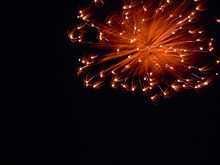
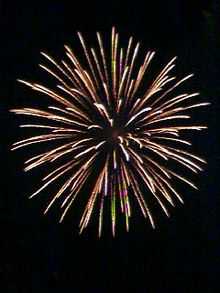
A shell containing a relatively few large comet stars arranged in such a way as to burst with large arms or tendrils, producing a palm tree-like effect. Proper palm shells feature a thick rising tail that displays as the shell ascends, thereby simulating the tree trunk to further enhance the "palm tree" effect. One might also see a burst of color inside the palm burst (given by a small insert shell) to simulate coconuts.
Ring

A shell with stars specially arranged to create a ring like shape. Variations include smiley faces, hearts, and clovers.
Diadem
The diadem is a type of Peony or Chrysanthemum with a center cluster of non-moving stars, normally of a contrasting color or effect.
Kamuro
Kamuro is a Japanese word meaning "Boys haircut" which is what this shell looks like when fully exploded in the air. A dense burst of glittering silver or gold stars which leave a heavy glitter trail and are very shiny in the night's sky.
Crossette

Crossette is an effect characterized by a "star" which quickly shoots outward in four directions from the initial comet. When multiple crossette shells are fired simultaneously, the result is a mass of criss-crossing trails, hence the name "crossette". Each specialized star in a crossette shell contains a small shot hole that effectively divides the star into four sides. The shot hole is packed with an explosive powder. When the charge ignites, the star splits into four segments that propel outward. Once limited to silver or gold effects, colored crossettes such as red, green, or white are now very common.
Spider
A shell containing a fast burning tailed or charcoal star that is burst very hard so that the stars travel in a straight and flat trajectory before slightly falling and burning out. This appears in the sky as a series of radial lines much like the legs of a spider.
Horsetail
Named for the shape of its break, this shell features heavy long-burning tailed stars that only travel a short distance from the shell burst before free-falling to the ground. Also known as a waterfall shell. Sometimes there is a glittering through the "waterfall."
Time rain
The time rain is an effect created by large, slow-burning stars within a shell that leave a trail of large glittering sparks behind and make a sizzling noise. The "time" refers to the fact that these stars burn away gradually, as opposed to the standard brocade "rain" effect where a large amount of glitter material is released at once.
Multi-break shells
A large shell containing several smaller shells of various sizes and types. The initial burst scatters the shells across the sky before they explode. Also called a bouquet shell. When a shell contains smaller shells of the same size and type, the effect is usually referred to as "Thousands". Very large bouquet shells (up to 48 inches) are frequently used in Japan.
Fish
Shells that have the property of launching the flaming debris in all different directions are known as fish. Also, what gives them their identities are the flares swarming in random directions.
Salute
A shell intended to produce a loud report rather than a visual effect. Salute shells usually contain flash powder, producing a quick flash followed by a very loud report. Titanium may be added to the flash powder mix to produce a cloud of bright sparks around the flash. Salutes are commonly used in large quantities during finales to create intense noise and brightness. They are often cylindrical in shape to allow for a larger payload of flash powder, but ball shapes are common and cheaper as well. Salutes are also called Maroons. Another type of salute is the lampare. A lampare shell has the flash powder used in a regular salute, but is filled with a flammable liquid. When the shell explodes it has a loud report with a fireball.
Mine
A mine (aka. pot à feu) is a ground firework that expels stars and/or other garnitures into the sky. Shot from a mortar like a shell, a mine consists of a canister with the lift charge on the bottom with the effects placed on top. Mines can project small reports, serpents, small shells, as well as just stars. Although mines up to 12 inches (300 mm) in diameter appear on occasion, they are usually between 3 and 5 inches (76 and 127 mm) in diameter.
Bengal fire
Bengal fire or Bengal light produces a steady, vivid, blue-colored light.[37] It is often made using combinations of potassium nitrate and copper compounds.[38][39]
Roman candle
A Roman candle is a long tube containing several large stars which fire at a regular interval. These are commonly arranged in fan shapes or crisscrossing shapes, at a closer proximity to the audience. Some larger Roman candles contain small shells (bombettes) rather than stars.
Cake
A cake is a cluster of individual tubes linked by fuse that fires a series of aerial effects. Tube diameters can range in size from 1⁄4 to 4 inches (6 to 100 mm), and a single cake can have over 1,000 shots. The variety of effects within individual cakes is often such that they defy descriptive titles and are instead given cryptic names such as "Bermuda Triangle", "Pyro Glyphics", "Summer Storm", "Waco Wakeup", and "Poisonous Spider", to name a few. Others are simply quantities of 2.5"-4" shells fused together in single-shot tubes.
Noise-related effects
 |
Fireworks
|
| Problems playing this file? See media help. | |
Bangs and report
The bang is the most common effect in fireworks and sounds like a gunshot, technically called a report.
Crackle
The firework produces a crackling sound.
Hummers
Tiny tube fireworks that are ejected into the air spinning with such force that they shred their outer coating, in doing so they whizz and hum.
Whistle
High pitched often very loud screaming and screeching created by the resonance of gas. This is caused by a very fast strobing (on/off burning stage) of the fuel. The rapid bursts of gas from the fuel vibrate the air many hundreds of times per second causing the familiar whistling sound. It is not – as is commonly thought – made in the conventional way that musical instruments are using specific tube shapes or apertures. Common whistle fuels contain benzoate or salicylate compounds and a suitable oxidizer such as potassium perchlorate.
Laws and politics
Safety of commercial and display fireworks in Canada

Fireworks safety is considered to be extremely important in Canada. The use, storage and sale of commercial-grade fireworks in Canada is licensed by Natural Resources Canada's Explosive Regulatory Division (ERD). Unlike their consumer counterpart, commercial-grade fireworks function differently, and come in a wide range of sizes from 50 mm (2 inches) up to 300 mm (12 inches) or more in diameter.
Commercial grade fireworks require a "Fireworks Operator certificate", obtained from the ERD by completing a one day safety course. The certification system consists of three levels: Assistant, Supervisor, and Supervisor with Endorsements. Assistants can only work under direct supervision of a Supervisor. Supervisor certification is gained after assisting three shows within the past five years. Supervisors can independently use and fire most commercial grade pyrotechnics. Supervisor with Endorsements certification can be obtained after supervising three shows within the past five years, and allows the holder to fire from barges, bridges, rooftops and over unusual sites.[40]
Since commercial-grade fireworks are shells which are loaded into separate mortars by hand, there is danger in every stage of the setup.[41] Setup of these fireworks involves: the placement and securing of mortars on wooden or wire racks; loading of the shells; and if electronically firing, wiring and testing. The mortars are generally made of FRE (Fiber-Reinforced Epoxy) or HDPE (High-Density Polyethelene), some older mortars are made of sheet steel, but have been banned by most countries due to the problem of shrapnel produced during a misfire.
Setup of mortars in Canada for an oblong firing site require that a mortar be configured at an angle of 10 to 15 degrees down-range with a safety distance of at least 200 meters (656 ft) down-range and 100 meters (328 ft) surrounding the mortars, plus distance adjustments for wind speed and direction. In June 2007, the ERD approved circular firing sites for use with vertically fired mortars with a safety distance of at least 175 meter (574 ft) radius, plus distance adjustments for wind speed and direction.[42]
Loading of shells is a delicate process, and must be done with caution, and a loader must ensure not only the mortar is clean, but also make sure that no part of their body is directly over the mortar in case of a premature fire. Wiring the shells is a painstaking process; whether the shells are being fired manually or electronically, with any "chain fusing" or wiring of electrical igniters care must be taken to prevent the fuse (an electrical match, often incorrectly called a squib) from igniting. If the setup is wired electrically, the electrical matches are usually plugged into a "firing rail" or "breakout box" which runs back to the main firing board; from there, the firing board is simply hooked up to a car battery, and can proceed with firing the show when ready. After the display, the operators must ensure the site is inspected for misfired or unfired materials within 30 minutes of the conclusion of the show. Further, they must return the next day, during daylight, to reinspect the area again.[40]
Safety of consumer fireworks in Great Britain
The safety of consumer fireworks in England, Scotland, and Wales is always a widely discussed topic around Guy Fawkes Night, November 5. The most common injuries are burns from hand-held fireworks such as sparklers. There are also injuries due to people being hit by projectiles fired from fireworks, although these can usually be explained by people setting up fireworks incorrectly. Other issues include the dangers of falling rocket sticks, especially from larger rockets containing metal motors.
"Shock" adverts have been used for many years in an attempt to restrict injuries from fireworks, especially targeted at young people. The vast majority of fireworks are "Category 3, (Display Fireworks)" all of which state that spectators must be at least 25 meters (82 ft) away when the firework is fired. This is a safety concern as few people have access to that amount of private space. Other categories include "Category 2 (Garden Fireworks)" for which spectators must be a minimum of 8 meters (26 ft 3 in) away when the firework is fired, and "Category 4 – Professional Use Only". Any firework classed as Category 4 may only be used by professional pyrotechnists and must not be sold to the general public.
Safety of commercial and display fireworks in the United Kingdom
In the UK, responsibility for the safety of firework displays is shared between the Health and Safety Executive, fire brigades and local authorities. Currently, there is no national system of licensing for fireworks operators, but in order to purchase display fireworks, operators must have licensed explosives storage and public liability insurance.
Safety of consumer fireworks in the United States

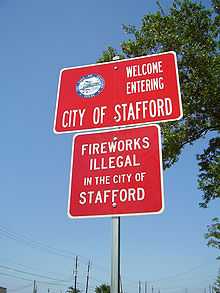

Availability and use of consumer fireworks are hotly debated topics. Critics and safety advocates point to the numerous injuries and accidental fires that are attributed to fireworks as justification for banning or at least severely restricting access to fireworks. Complaints about excessive noise created by fireworks and the large amounts of debris and fallout left over after shooting are also used to support this position. There are numerous incidents of consumer fireworks being used in a manner that is supposedly disrespectful of the communities and neighborhoods where the users live.
Meanwhile, those who support more liberal firework laws look at the same statistics as the critics and conclude that, when used properly, consumer fireworks are a safer form of recreation than riding bicycles or playing soccer.[43]
The Consumer Product Safety Commission has guidelines concerning the standard of consumer fireworks sold in the US. Together with US Customs, they are very proactive in enforcing these rules, intercepting imported fireworks that don't comply and issuing recalls on unacceptable consumer fireworks that are found to have "slipped through". Bureau of Alcohol, Tobacco, Firearms and Explosives (ATF) is the federal agency that regulates explosives, including Display Fireworks in the US.
Many states have laws which further restrict access to and use of consumer fireworks, and some of these states such as New Jersey[44] vigorously enforce them. Each year, there are many raids on individuals suspected of illegally possessing fireworks.[45]
The U.S. Bureau of Alcohol, Tobacco, Firearms and Explosives (ATF) as well as the U.S. Consumer Product Safety Commission (CPSC) have general jurisdiction over what types of fireworks may be legally sold in the United States. The federal law is only the minimum standard however, and each state is free to enact laws that are more stringent if they so choose. Citing concerns over fireworks safety, some states, such as California, have enacted legislation restricting fireworks usage to devices that do not leave the ground, such as fountains. North Carolina limits fireworks to a charge of 200 grams (7.1 oz) of black powder. States such as New York, New Jersey, Massachusetts, and Delaware ban all consumer fireworks completely. Rhode Island and Arizona have recently passed bills legalizing certain types of small fireworks. On the other hand, states such as New Hampshire, South Dakota, South Carolina and Tennessee allow most or all legal consumer fireworks to be sold and used throughout the year. Michigan has recently overturned its ban on fireworks that leave the ground, allowing for the sale and use for the 1st time in 2012. New Mexico in some cases, will not allow fireworks from individual residents if the fireworks are said to detonate over 5 feet (1.5 m) in height.
Illinois only permits sparklers, snake/glow worm pellets, smoke devices, trick noisemakers, and plastic or paper caps.[46] However, many users travel to neighboring states such as Indiana, Missouri, Kentucky, and Wisconsin to obtain fireworks for use in Illinois.[47] This situation is similar to the plight of many St. Louis residents as fireworks are illegal within both city and county limits. However, fireworks are readily available in nearby St. Charles County.
Pennsylvania is somewhere in between; the law only allows fireworks that don't leave the ground to be sold and used by residents. Yet residents from out of state and Pennsylvania residents with a permit can buy any consumer fireworks from an outlet.
Differences in legislation among states have led many fireworks dealers to set up shop along state borders in order to attract customers from neighboring states where fireworks are restricted. Some Native American tribes on reservation lands show similar behavior, often selling fireworks that are not legal for sale outside of the reservation.
The type of fireworks sold in the United States vary widely, from fireworks which are legal under federal law, all the way to illegal explosive devices/professional fireworks that are sold on the black market. Both the illicit manufacture and diversion of illegal explosives to the consumer market have become a growing problem in recent years.
Pollution
Fireworks produce smoke and dust that may contain residues of heavy metals, sulfur-coal compounds and some low concentration toxic chemicals. These by-products of fireworks combustion will vary depending on the mix of ingredients of a particular firework. (The color green, for instance, may be produced by adding the various compounds and salts of Barium, some of which are toxic, and some of which are not.) Some fishermen have noticed and reported to environmental authorities that firework residues can hurt fish and other water-life because some may contain toxic compounds such as antimony sulfide. This is a subject of much debate because large-scale pollution from other sources makes it difficult to measure the amount of pollution that comes specifically from fireworks. The possible toxicity of any fallout may also be affected by the amount of black powder used, type of oxidizer, colors produced and launch method.
Fireworks have also been noted as a source of perchlorate in lakes.[48] The U. S. Environmental Protection Agency's Richard Wilkin and colleagues have conducted research on the use of pyrotechnic devices over bodies of water, noting concerns over the effects of environmental perchlorate on human health and wildlife. Sources of perchlorate range from lightning and certain fertilizers to the perchlorate compounds in rocket fuel and explosives. Scientists long suspected community fireworks displays were another source, but few studies had been done on the topic. Wilkin's group has now established fireworks displays as a source of perchlorate contamination by analyzing water in an Oklahoma lake before and after fireworks displays in 2004, 2005 and 2006. Within 14 hours after the fireworks, perchlorate levels rose 24 to 1,028 times above background levels. Levels peaked about 24 hours after the display, and then decreased to the pre-fireworks background within 20 to 80 days. The study is detailed in the June 1, 2007 issue of the journal Environmental Science & Technology. ( Environ. Sci. Technol., 2007, 41 (11), pp 3966–3971)[49]
Perchlorate, a type of salt in its solid form, dissolves and moves rapidly in groundwater and surface water. Even in low concentrations in drinking water supplies, perchlorate is known to inhibit the uptake of iodine by the thyroid gland. While there are currently no federal drinking water standards for perchlorate, some states have established public health goals, or action levels, and some are in the process of establishing state maximum contaminant levels. For example, the US Environmental Protection Agency conducted studies on the impacts of perchlorate on the environment as well as drinking water.[50] California has also issued guidance regarding perchlorate use.[51]
Several states have enacted drinking water standard for perchlorate including Massachusetts in 2006. California's legislature enacted AB 826, the Perchlorate Contamination Prevention Act of 2003, requiring California's Department of Toxic Substance Control (DTSC) to adopt regulations specifying best management practices for perchlorate and perchlorate-containing substances. The Perchlorate Best Management Practices were adopted on December 31, 2005 and became operative on July 1, 2006.[52] California issued drinking water standards in 2007. Several other states, including Arizona, Maryland, Nevada, New Mexico, New York, and Texas have established non-enforceable, advisory levels for perchlorate.
The courts have also taken action with regard to perchlorate contamination. For example, in 2003, a federal district court in California found that Comprehensive Environmental Response, Compensation and Liability Act (CERCLA) applied because perchlorate is ignitable and therefore a “characteristic” hazardous waste. (see Castaic Lake Water Agency v. Whittaker, 272 F. Supp. 2d 1053, 1059–61 (C.D. Cal. 2003)).
Pollutants from fireworks raise concerns because of potential health risks associated with hazardous by-products. For most people the effects of exposure to low levels of toxins from many sources over long periods are unknown. For persons with asthma or multiple chemical sensitivity the smoke from fireworks may aggravate existing health problems.[53] Environmental pollution is also a concern because heavy metals and other chemicals from fireworks may contaminate water supplies and because fireworks combustion gases might contribute to such things as acid rain which can cause vegetation and even property damage. However, gunpowder smoke and the solid residues are basic, and as such the net effect of fireworks on acid rain is debatable. The carbon used in fireworks is produced from wood and does not lead to more carbon dioxide in the air. What is not disputed is that most consumer fireworks leave behind a considerable amount of solid debris, including both readily biodegradable components as well as nondegradable plastic items. Concerns over pollution, consumer safety, and debris have restricted the sale and use of consumer fireworks in many countries. Professional displays, on the other hand, remain popular around the world.
Others argue that alleged concern over pollution from fireworks constitutes a red herring, since the amount of contamination from fireworks is minuscule in comparison to emissions from sources such as the burning of fossil fuels. In the US some states and local governments restrict the use of fireworks in accordance with the Clean Air Act which allows laws relating to the prevention and control of outdoor air pollution to be enacted. Few governmental entities, by contrast, effectively limit pollution from burning fossil fuels such as diesel fuel or coal. Coal fueled electricity generation alone is a much greater source of heavy metal contamination in the environment than fireworks.
Some companies within the U.S. fireworks industry claim they are working with Chinese manufacturers to reduce and ultimately hope to eliminate of the pollutant perchlorate.[54]
In February 2013, the China News Service reported that residents of the capital city Beijing were asked to reduce fireworks during the traditional Lantern Festival due to record air pollution.[55]
Laws governing consumer fireworks
Australia


In Australia, Type 1 fireworks (sparklers, party poppers or similar below prescribed sizes)[56] are permitted to be sold to the public. For anything that has a large explosion or gets airborne, users need to register for a Type 2 Licence. On August 24, 2009 the ACT Government announced a complete ban on backyard fireworks.[57] The Northern Territory allows fireworks to be sold to residents 18 years or older on Northern Territory Day (July 1) between the hours of 9am and 9pm for personal purposes. The types of fireworks allowed for sale is restricted to quieter fireworks, which can only be used at the address provided to the seller. [citation needed]

Chile
In Chile, the manufacture, importation, possession and use of fireworks is prohibited to unauthorized individuals; only certified firework companies can legally use fireworks. As they are considered a type of explosive, offenders can be tried before military courts, though this is not often used.
Croatia
In Croatia, 1st class fireworks (all kinds of weak fireworks, mostly firecrackers) can be sold and used throughout the entire year and anyone 14 or older can buy them. 2nd class (stronger than 1st class, mostly rockets, boxes and firecrackers) and 3rd class (larger boxes, the strongest firecrackers) fireworks can only be sold and used from the December 15 until the January 1 and can not be sold to anyone under 18 years of age, as they can cause serious injury if misused. [citation needed]
Finland
In Finland those under 18 years old have not been allowed to buy any fireworks since 2009. Safety goggles are required. The use of fireworks is generally allowed on the evening and night of New Year's Eve, December 31. In some municipalities of Western Finland it is allowed to use fireworks without a fire station's permission on the last weekend of August. With the fire station's permission, fireworks can be used year round.
France
In France, fireworks are legislated into four different classes, defined by total weight of explosive material. These are: (K1) small firecrackers under 3g (0.11 oz) and Roman candles under 10g (0.35 oz) which can be sold to minors over the age of 12; (K2) firecrackers and candles under 100g (3.53 oz) which can be sold to anyone over the age of majority, as can (K3) bombs and scenic fireworks with under 500g (1.1 lbs) of explosive; (K4) all other fireworks or explosives launched by mortar which are only sold to licensed professionals. Fireworks usage of any class requires the authorization of the town hall of the local community, as well as the notification of the fire brigade.[58]
Iceland
In Iceland, the Icelandic law states that anyone may purchase and use fireworks during a certain period around New Year's Eve. Most places that sell fireworks in Iceland make their own rules about age of buyers; usually it is around 16. The people of Reykjavík spend enormous sums of money on fireworks, most of which are fired as midnight approaches on December 31. As a result, every New Year's Eve the city is lit up with fireworks displays.
Ireland
In Ireland, the law on fireworks is governed by Part 6 of the Criminal Justice Act 2006. Generally, fireworks are illegal. Private fireworks displays are allowed on two conditions; the fireworks must be licensed for import and a professional fireworks operator must be used. Licenses are free and only granted on application to the Department of Justice for a specific event. Grant of a license also requires public liability insurance and the assent of the local police and fire marshall.[59]
Importation, sale or use of fireworks even on private property can result in a fine of up to €10,000 and/or up to five years in prison. Police are also empowered to search any person or vehicle without a warrant if they suspect fireworks may be found. Any person who police reasonably suspect of a fireworks related offence can also be arrested without a warrant and held for questioning for up to 12 hours.[59]
Despite the law, around Halloween and New Year's Eve a large amount of fireworks are set off, many smuggled across the border from Northern Ireland.
Large licensed public fireworks displays are commonplace around Saint Patrick's Day (Skyfest), Midsummer, Halloween and New Year's Eve.
Italy
In Italy only certified fireworks are legal. Homemade fireworks and fireworks not approved by Italian authorities are illegal. Fireworks are divided into three classes: "free fireworks" which can be sold to people over the age of 14, Cat. V fireworks can be purchased by people over the age of 18 and Cat. IV professional fireworks that require a firearms license.[60]
Netherlands

In the Netherlands, fireworks cannot be sold to anyone under the age of 12.[61] They may only be sold during a period of three days before a new year. If one of these days is a Sunday, that day is excluded from sale and sale may commence one day earlier.[62] Fireworks may only be set off at December 31 after 10:00am.
New Zealand
Fireworks in New Zealand are available from the 2nd to the November 5, around Guy Fawkes Night, and may be purchased only by those 18 years of age and older (up from 14 years pre-2007). Despite the restriction on when fireworks may be sold, there is no restriction regarding when fireworks may be used. The types of fireworks available to the public are multi-shot "cakes", Roman candles, single shot shooters, ground and wall spinners, fountains, cones, sparklers, and various novelties, such as smoke bombs and Pharaoh's serpents.
Norway
In Norway, fireworks can only be purchased and used by people 18 or older. Sale is restricted to a few days before New Year's Eve. Rockets are not allowed as of 2009.[63]
Philippines

Sweden
In Sweden, people under the age of 18 are not allowed to purchase fireworks. The most common and only types on the market for the general public in Sweden are rockets and cakes with a caliber of up to 49 mm. Fire cracker types are banned since December 1, 2001 because of a statistically high number of accidents reported past years.
Switzerland
In Switzerland, fireworks are often used on the 1 August, which is the Swiss National Day, and on New Year's Eve.
A grand musical firework takes place every year in Geneva, during the Fêtes de Genève, on a Saturday evening in mid-August.
United Kingdom
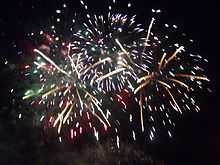
In the United Kingdom fireworks cannot be sold to people under the age of 18 and are not permitted to be set off between 11 p.m. and 7 a.m. with exceptions only for:
- New Year (Midnight New Year's Eve, valid until 1 a.m.)[64]
- Bonfire Night (November 5) (Valid until midnight)[64]
- The Chinese New Year (Valid until 1 a.m.)[64]
- Diwali (Valid until 1 a.m.)[64]
The legal NEC (Net Explosive Content) of a UK Firework available to the public is 2 kilograms (4.4 lbs). Jumping Jacks, Strings of Firecrackers, Shell Firing tubes, Bangers and Mini-Rockets were all banned during the late 1990s. In 2004 single shot Air Bombs and Bottle Rockets were banned, and rocket sizes were limited. From March 2008 any firework with over 5% flashpowder per tube will be classified 1.3G. The aim of these measures was to eliminate "pocket money" fireworks, and to limit the disruptive effects of loud bangs.
United States
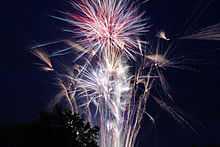
In the United States, the laws governing consumer fireworks vary widely from state to state, or from county to county. It is common for consumers to cross state and county lines in order to purchase types of fireworks which are outlawed in their home-jurisdictions. Fireworks laws in urban areas typically limit sales or use by dates or seasons. Municipalities may have stricter laws than their counties or states do. In the United States, fireworks dealers generally only sell to people over 16 or 18 years of age.
The American Pyrotechnic Association maintains a directory of state laws pertaining to fireworks.
Three states (Delaware, Massachusetts, New Jersey) ban the sale, but not use, of all consumer fireworks including novelties and sparklers by the general public.
One state (Arizona) permits residents to purchase and use all non-aerial fireworks such as novelties, fountains, sparklers, and smoke bombs, while still prohibiting firecrackers.
Three states (Illinois, Iowa, and New York) permit residents to purchase and use only wire or wood stick sparklers and other novelties. Certain counties in New York prohibit sparklers, but allow their use and possession.
Seventeen states (California, Colorado, Connecticut, Florida, Georgia, Idaho, Maryland, Minnesota, Nebraska, North Carolina, Oregon, Pennsylvania, Rhode Island, Utah, Virginia, Wisconsin, West Virginia, and the District of Columbia) allow residents to purchase and use non-aerial and non-explosive fireworks like novelties, fountains and sparklers. Wisconsin also allows the purchase of aerial explosive fireworks, but only allows their launch in designated areas in each county.
For example: California has very specific requirements for the types of consumer fireworks that can be sold to and used by residents. Even then each city can and often does place restrictions on sale and use. However, the manufacture of fireworks is legal throughout the state if they are to be used as an artform and not further distributed.
Another example: In Minnesota only consumer fireworks that do not explode or fly through the air are now permitted to be sold to and used by residents. In Nebraska the sale and use of all consumer fireworks are prohibited in Omaha as of December 31, 2010, while in Lincoln there is a two-day selling period and in other parts of the state all of the permitted types can be sold and used by residents.

Twenty four states (Alabama, Alaska, Arkansas, Indiana, Kansas, Kentucky, Louisiana, Maine (Maine's new law became effective January 1, 2012), Michigan, Mississippi, Missouri, Montana, New Hampshire, New Mexico, North Dakota, Ohio, Oklahoma, South Carolina, South Dakota, Tennessee, Texas, Vermont, Washington and Wyoming) permit the sale of all or most types of consumer fireworks to residents. Many of these states have selling seasons around Independence Day and/or Christmas and New Year's Eve. Some of these states also allow local laws or regulations to further restrict the types permitted or the selling seasons.
For example: Missouri permits all types of consumer fireworks to be sold to residents with two selling seasons; June 20 – July 10 and December 20 – January 2. South Carolina permits all types of consumer fireworks except small rockets less than ½” in diameter and 3” long to be sold and used by residents year round.
Two states (Hawaii and Nevada) allow each county to establish their own regulations. For example, Clark County, Nevada, where Las Vegas is located, allows residents to purchase and use only non-explosive and non-aerial consumer fireworks during Independence Day, while other counties permit all types of consumer fireworks.
Many states have stores with all types of consumer fireworks that sell to non-residents with the provision they are to remove the purchased fireworks from that state. This is why there are so many stores selling all types of consumer fireworks in states like Pennsylvania, Ohio, Florida, Missouri, Nevada and Wisconsin, even though residents are limited or prohibited from buying or using those very same consumer fireworks unless they have the appropriate licenses and/or permits.
Many Native American Tribes have consumer fireworks stores on reservation lands that are exempt from state and local authority and will sell to people that are not in the tribe.
References
- ↑ 1.0 1.1 Needham, Joseph (1987). Science & Civilisation in China, volume 7: The Gunpowder Epic. Cambridge University Press. p. 142. ISBN 0-521-30358-3.
- ↑ "Fireworks And Religious Events | Equality and Religious Freedom". Concilionacionalevangelico.org. Retrieved 2012-11-16.
- ↑ 3.0 3.1 3.2 Temple, Robert K.G. (2007). The Genius of China: 3,000 Years of Science, Discovery, and Invention (3rd edition). London: André Deutsch, pp. 256–265. ISBN 978-0-233-00202-6
- ↑ "Shining through". China Daily. Retrieved October 2, 2011.
- ↑ "3D Globe using only fire power". Saint Philip's Fireworks Factory. Retrieved June 6, 2008.
- ↑ Hutchins, Paul (2009). The secret doorway: Beyond imagination. Imagination Publishing. p. 27. ISBN 978-0-9817123-3-8.
- ↑ Gernet, Jacques (1962). Daily Life in China on the Eve of the Mongol Invasion, 1250–1276. Translated by H.M. Wright. Stanford: Stanford University Press, pp. 186. ISBN 0-8047-0720-0.
- ↑ Kelly, Jack (2004). Gunpowder: Alchemy, Bombards, and Pyrotechnics: The History of the Explosive that Changed the World. New York: Basic Books, Perseus Books Group, page 2.
- ↑ Crosby, Alfred W. (2002), Throwing Fire: Projectile Technology Through History. Cambridge: Cambridge University Press. ISBN 0-521-79158-8. Pages 100–103.
- ↑ Needham, Volume 5, Part 7, 489–503.
- ↑ Kelly, Jack (2004). Gunpowder: Alchemy, Bombards, & Pyrotechnics: The History of the Explosive that Changed the World. Basic Books, page 22. ISBN 0-465-03718-6.
- ↑ 12.0 12.1 Werrett, Simon (2010). Fireworks: Pyrotechnic arts and sciences in European history. Chicago: The University of Chicago Press. p. 181. ISBN 978-0-226-89377-8.
- ↑ 13.0 13.1 Werrett, Simon (2010). Fireworks: Pyrotechnic arts and sciences in European history. Chicago: The University of Chicago Press. p. 183. ISBN 978-0-226-89377-8.
- ↑ Werrett, Simon (2010). Fireworks: Pyrotechnic arts and sciences in European history. Chicago: The University of Chicago Press. pp. 144–145. ISBN 978-0-226-89377-8.
- ↑ "Fireworks Frighten Animals". Animal Aid. October 26, 2007. Retrieved June 24, 2010.
- ↑ "Fireworks Thunder and Pets – Safety considerations for noise phobias – fireworks and thunder". Vetmedicine.about.com. Retrieved June 24, 2010.
- ↑ "How should I care for my pets during fireworks displays? – RSPCA Australia knowledgebase". Kb.rspca.org.au. August 17, 2009. Retrieved June 24, 2010.
- ↑ "Burning Question: Why do dogs hate fireworks?". shine.yahoo.com. July 3, 2012. Retrieved July 13, 2012.
- ↑ http://www.guinnessworldrecords.com/news/2013/12/watch-live-stream-here-dubai-attempts-new-year%E2%80%99s-eve-fireworks-world-record-54187/
- ↑ "World's biggest Catherine Wheel is fired in Malta". Retrieved September 18, 2011.
- ↑ "Firework – largest Catherine wheel". Guinness World Records. Retrieved September 18, 2011.
- ↑ "Longest firework waterfall". Guinness World Records. Retrieved September 18, 2011.
- ↑ "Most firework rockets launched in 30 seconds". Guinness World Records. Retrieved September 18, 2011.
- ↑ "Largest firework rocket". Guinness World Records. Retrieved September 18, 2011.
- ↑ "CrackerJacks". CrackerJacks. Retrieved 2012-11-16.
- ↑ "PGI.org". PGI.org. Retrieved 2012-11-16.
- ↑ "WPA.org". WPA.org. Retrieved 2013-01-24.
- ↑ Banks of the Foyle Halloween Carnival 2010
- ↑ "Summer: the season of 'fire flowers' | The Japan Times Online". Search.japantimes.co.jp. 2010-07-14. Retrieved 2012-11-16.
- ↑ Walt Disney Company (June 28, 2004). Disney debuts new safer, quieter and environmentally friendlier fireworks technology. Press Release
- ↑ http://money.cnn.com/2007/06/25/smbusiness/zambelli_fireworks/
- ↑ http://www.businessweek.com/articles/2013-06-27/zambelli-and-pyro-tecnico-super-producers-of-fireworks-shows
- ↑ Susan Befield, "Zambelli and Pyrotecnico, Super-Producers of Fireworks Shows" Bloomberg Businessweek, June 27, 2012.
- ↑ Nick Leiber, "China Makes America's Fireworks by hand. This Inventor has faster Way", Bloomberg Businessweek, July 1, 2013]
- ↑
- ↑
- ↑ The World Book Dictionary - Google Boeken. Books.google.com. Retrieved 2012-11-16.
- ↑ "Bengal fire". Everything2.com. 2009-03-24. Retrieved 2012-11-16.
- ↑ "Pyrotechnics in Fireworks". Ingentaconnect.com. 2004-06-01. Retrieved 2012-11-16.
- ↑ 40.0 40.1 Display Fireworks Manual 2010
- ↑ Natural Resources Canada, Explosive Regulatory Division. Display Fireworks Manual (March 2002 Edition)
- ↑ "Natural Resources Canada Explosive Branch Bulletin #48". Web.archive.org. 2008-02-27. Retrieved 2012-11-16.
- ↑ "Fireworks: safer than candles, tableware." Dave Stoddard, Sacramento Ledger Dispatch, July 14, 2006.
- ↑ http://www.strausnews.com/articles/2007/07/15/advertiser_news/news/27.txt
- ↑ "New Jersey confiscates 4 tons of Pennsylvania-bought fireworks | NJ.com". Blog.nj.com. Retrieved 2012-11-16.
- ↑ "425 ILCS 35/ Fireworks Use Act". Ilga.gov. 2003-10-17. Retrieved 2012-11-16.
- ↑ "e-Editions". Daily-journal.com. Retrieved June 24, 2010.
- ↑ "Fireworks Displays Linked To Perchlorate Contamination In Lakes". Sciencedaily.com. 2007-05-28. Retrieved 2012-11-16.
- ↑ "Perchlorate Behavior in a Municipal Lake Following Fireworks Displays – Environmental Science & Technology (ACS Publications)". Pubs.acs.org. Retrieved June 24, 2010.
- ↑ "Perchlorate | Drinking Water Contaminants | Safewater | Water | US EPA". Epa.gov. Retrieved June 24, 2010.
- ↑ "Perchlorate in Drinking Water". Cdph.ca.gov. Retrieved June 24, 2010.
- ↑ "Perchlorate". Dtsc.ca.gov. Retrieved June 24, 2010.
- ↑ New Scientist – Great fireworks, shame about the toxic fallout
- ↑ Knee, Karen. Philadelphia Inquirer. Jul 4, 2009. Pa. company works to make fireworks greener
- ↑ Bloomberg News "Beijing Acts to Reduce Fireworks as Air Worsens, China News Says, Feb 24, 2013
- ↑ "Workplace Standards Tasmania : Type 1 (Indoor)". Wst.tas.gov.au. 2012-01-10. Retrieved 2012-11-16.
- ↑ "Cracker down: ACT bans fireworks". Australian Broadcasting Corporation. August 24, 2009. Retrieved August 24, 2009.
- ↑ "La législation". TPS feux d'artifices. Retrieved July 4, 2011.
- ↑ 59.0 59.1 "The law on fireworks". Retrieved 27 September 2012.
- ↑ "Guide: fuochi d'artificio, un pò di chiarezza". Poliziadistato.it. 2006-12-15. Retrieved 2012-11-16.
- ↑ http://www.politie.nl/onderwerpen/vuurwerk.html#vanaf-welke-leeftijd-mag-ik-vuurwerk-kopen
- ↑ "Article 2.3.5 of the Besluit van 22 januari 2002, houdende nieuwe regels met betrekking tot consumenten- en professioneel vuurwerk (Vuurwerkbesluit) Decision of January 22, 2002, laying down new rules on consumer and professional fireworks (Fireworks Decision)". Vuurwerkbesluit (in Dutch). January 22, 2002. Retrieved April 20, 2009.
- ↑ "Norsk brannvernforening: Fyrverkeri". Brannvernforeningen.no. Retrieved 2012-11-16.
- ↑ 64.0 64.1 64.2 64.3 Statutory Instrument 2004 No. 1836 The Fireworks Regulations 2004, United Kingdom.
Further reading
- Plimpton, George (1984). Fireworks: A History and Celebration. Doubleday. ISBN 0-385-15414-3.
- Brock, Alan St. Hill (1949). A History of Fireworks. George G. Harrap & Co.
- Russell, Michael S (2008). The chemistry of fireworks. Royal Society of Chemistry, Great Britain. ISBN 978-0-85404-127-5.
- Shimizu, Takeo (1996). Fireworks: The Art, Science, and Technique. Pyrotechnica Publications. ISBN 978-0-929388-05-2.
- Werrett, Simon (2010). Fireworks: Pyrotechnic Arts and Sciences in European History. University of Chicago Press. ISBN 978-0-226-89377-8.
- Kazuma, Saeki (2004). Hanabi−no Hon(Fireworks Book). Tankosha. ISBN 4-473-03177-2.
- Kazuma, Saeki (2011). Wonder of Fireworks. Soft Bank Creative. ISBN 978-4-7973-6450-7.
External links
| Wikimedia Commons has media related to Fireworks. |
- NOVA Online Kaboom! with pyrotechnics, anatomy of fireworks, etc
- Canadian Fireworks Association ACP
- The Science of Fireworks, demonstration lecture on the history of the modern firework
- Video of a firework display on November 5th in Swansea, Wales
